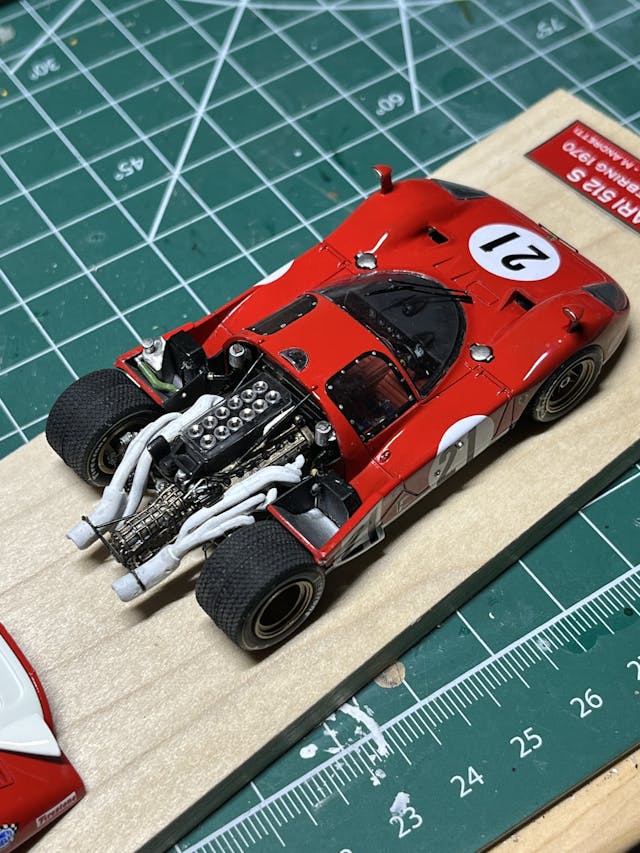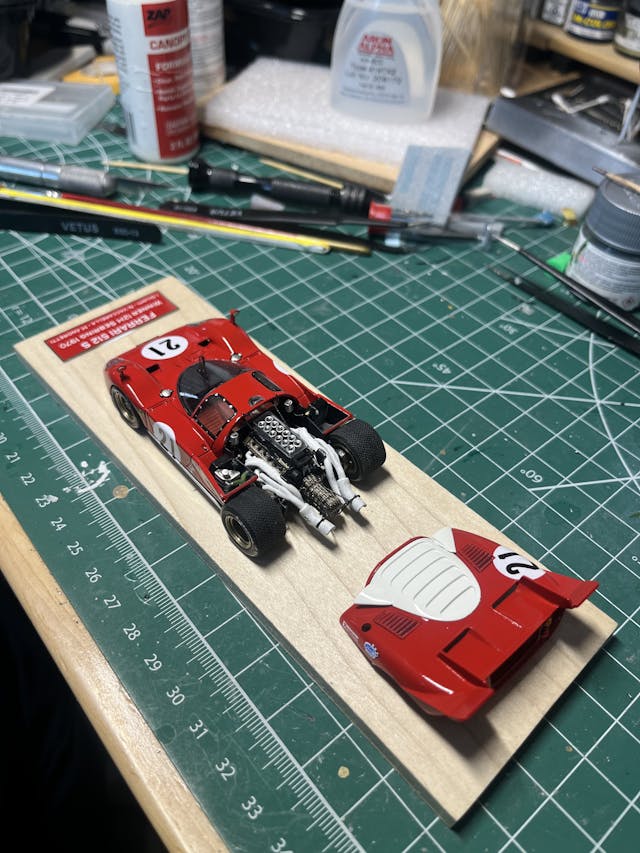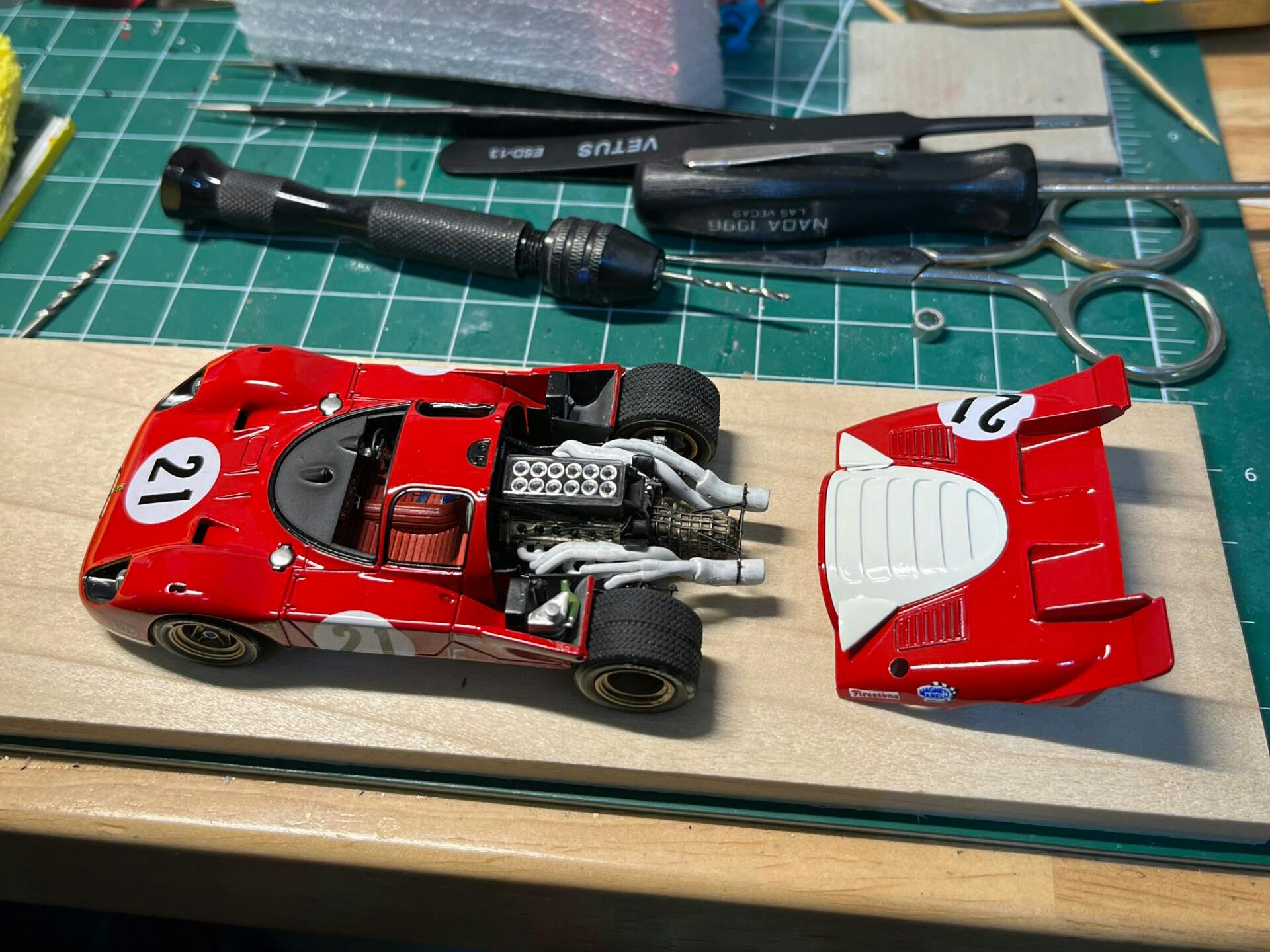Media | Articles
My part-time modeling gig is the gift that keeps on giving
Four months of squinting through jewelers’ glasses at a tiny lump of metal molded in the shape of a 1970 Ferrari 512S and I declared—well, not victory, exactly, but a sort of détente. I had run out of parts to stick on it and would have to settle for what I believed to be the flawed result of a truly absurd tally of hours. The headlight lenses that didn’t fit quite right. The decals that didn’t lie down across the contours perfectly. The little globby beads where I had gotten a bit too effusive with the glue. Then I took the glasses off and gazed upon my work with failing middle-aged eyes now shorn of 3.5x magnification. And I had to admit that the finished product didn’t completely suck.
I started building 1/43rd-scale models in high school because I like miniature things and the smaller, the better. Plus, my attention span was too short to build the bigger 1/20th- and 1/12th-scale plastic jobs that have a billion parts. Then I quit for 30 years to focus on real cars. A couple of years ago, I took up modeling again, throwing adult sums of money at it. I bought finely made tweezers and jewelers’ drills. I lined one whole wall of my office with paint jars from Japan, where modeling is still a national passion, and bought an imported airbrush and a paint booth with a fan to extract fumes through a filter. And I ordered the Rolls-Royce of magnifying glasses, with a choice of five lenses, a little swing-down monocle that provides extra-extra magnification, an adjustable padded headband, and an integrated rechargeable LED light.
Most of the companies of my youth are gone, killed off by a flood of Chinese die-casts and a generational shift away from hands-on hobbies. However, Tameo Kits, operating out of a small workshop in northwest Italy, still produces a few thousand kits each year from a catalog of more than 700 subjects, mostly 1970s and ’80s F1 cars and sports-racers. The company applies modern tech to its old-world product, such as computer-aided design and spin-casting of the white metal (a malleable mix of tin and copper that goes back to toy soldier days). Unlike the kits of my youth, which resembled lead fishing sinkers, Tameo’s exquisite kits fit together precisely with a minimum of filing and shaping.

That makes them a favorite among the modelers who like to work in the fiddly 1/43rd scale, a relic of early model railroading that reduces, say, Ayrton Senna’s 1988 championship-winning McLaren MP4/4 down to a tiny shelf sculpture barely 4 inches long. “Our kits aren’t exactly the easiest thing to assemble,” acknowledged company founder Luca Tameo when I emailed him some questions. “It takes skill and excellent equipment to be able to make a finished model of good quality.”
I follow expert builders on social media, which is both good for picking up tips and terrible for the ego. But I learned they also screw up and sometimes resort to dunking the whole model in solvent to start over. One Japanese builder, who goes by @hantyan2015 on Instagram, calls it “the Bath of Shame.”
Marketplace
Buy and sell classics with confidence

The Ferrari, a 250-piece kit of the car Mario Andretti helped crew to victory at the 1970 12 Hours of Sebring, was a challenge from my friend David Barnblatt, a video producer in LA who runs a side hustle called Vintage43.com selling model cars and kits. He corralled me and East Coaster Tim McNair, a skilled painter of both models and real cars, into building the same Tameo kit as a social media challenge. Tim finished first, producing a museum-quality model. I finished last, producing more of a 10-footer. Though the kit includes extensive instructions, we each applied our own artistic flourishes. David built his to resemble the restored car in modern times, while Tim and I both aimed to replicate the car as it raced back in the day.
That’s the great thing about building versus buying a pre-made die-cast; you make it the way you want it. That and the pride of creating a thing. Visitors to the house always ask me which of my far-too-many models I made myself, and I am eager to point them out. In the 21st century, when so many people spend so much free time staring at screens, old-fashioned hobbies like car-wrenching, woodworking, and model-making are a gift you give to your brain and hands and soul.
Your eyes—well, not so much.

***
This article first appeared in Hagerty Drivers Club magazine. Click here to subscribe and join the club.
Check out the Hagerty Media homepage so you don’t miss a single story, or better yet, bookmark it. To get our best stories delivered right to your inbox, subscribe to our newsletters.







Aaron – nice work! I was a modeler [like a zillion others] as a kid, but have recently dabbled a bit as an oldster. Some of what I’m working on are kits that’ve been boxed up since the ’60s, but I’m also kind of into replicating vehicles I’ve actually driven in my life. That’s challenging for me because there aren’t always kits and/or custom pieces that fit the exact rigs I’ve had – so sometimes I need to fab things. I’m currently making an exact 1:18 replica of my Pontiac, and trying to meet the challenge of getting all the stainless trim and chrome pieces to look right. I would never attempt the 1:43 scale you do, but I enjoy the tried-and-true 1:18 and 1:25 scales.
Nice work, sir! I too have returned to modeling after a multi-decade break. It’s become my preferred way to survive the eight-month Seattle rainy season.
So should we call you a “hand model” ? Kind of camera shy there. LoL.
I love model cars with lots of details and 1:18 diecast cars.
Good work. Some of us also miss crafting slot cars we’d race at the big eight-lane public track, as good as it got ’til we could get our hands on real cars.
I have been a modeler since childhood, and continue this fine hobby as a 70 year young man. I mostly do 1/24th scale, but have a few 1/32nd. Slot cars are also one of my treasures, and I have several built kits from the 1960s, as well as static models from the same era. It has become a challenge, as I have developed essential tremors, and I can’t keep my hands from shaking some days. I’ll keep trying. I hope that you do as many models as possible. Cars are rolling art.
“Cars are rolling art.” True enough — or should be. Most of us raced 1/24 or 1/25th kits, suitably customized, of course. Some raced 1/32, including home six-volt Strombecker set cars, which went like hell for a lap.
Having been away from model railroading for several years now, I’m remembering a product that is used to set decals. I can’t remember the name, but it does an excellent job of making the decal form to the shape of the model you’re applying it to. It follows in the grooves and other features in the body. Worked in HO because of space requirements. Kudos for being brave enough to work in 1/43 scale, I’d need a microscope to work in that scale now! Keep up the good work.
That reminds me that a I have a stack of unbuilt 1/87th scale (HO model railroad) trucks from Kibri and Preisser from the late 80s that I should build in the off season. These are fun because a lot of them have working details like Hiab cranes or my wheel loader with a back hoe attachment.
Congrats on a nice model. I have built models since I was,a kid, and have a 1/43 Tameo kit I’m starting. It’s the Ferrari 312 F1, and the detail of all the parts is exquisite. Incredible quality and attention to detail.